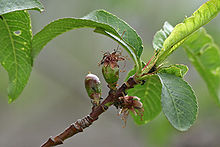Abscission
Abscission (from the Latin ab meaning away and scindere meaning to cut) is a term used in several areas of biology. In plant sciences it most commonly refers to the process by which a plant drops one or more of its parts, such as a leaf, fruit, flower or seed. In zoology the term may be used to describe the intentional shedding of a body part, such as the shedding of a claw husk, or the autotomy of a tail to evade a predator. In mycology it may refer to the liberation of a fungal spore. In cell biology abscission refers to the separation of two daughter cells at the completion of cytokinesis.
Abscission in plants
Function

A plant will abscise a part either to discard a member that is no longer necessary, such as a leaf during autumn, or a flower following fertilisation, or for the purposes of reproduction. Most deciduous plants drop their leaves by abscission before winter, while evergreen plants continuously abscise their leaves. Another form of abscission is fruit drop, when a plant abscises fruit while still immature, in order to conserve resources needed to bring the remaining fruit to maturity. If a leaf is damaged a plant may also abscise it to conserve water or photosynthetic efficiency, depending on the 'costs' to the plant as a whole. The abscission layer is a greenish grayish color.
Abscission can also occur in premature leaves as a means of plant defense. Premature leaf abscission has been shown to occur in response to infestation by gall aphids. By abscising leaves that have been made host to aphid galls, plants have been shown to massively diminish the pest population, as 98% of aphids in abscised galls died. The abscission is selective, and the chance of dropping leaves increases as the number of galls increase. A leaf with three or more galls was four times more likely to abscise than a leaf with one, and 20 times as likely to be dropped as a leaf without any galls.[1]
Structural mechanism
In deciduous trees, an abscission zone, also called a separation zone, is formed at the base of the petiole. It is composed of a top layer which has cells with weak walls, and a bottom layer which expands in the autumn, breaking the weak walls of the cells in the top layer. This allows the leaf to be shed.
In woody plants, an abscission layer is formed composed of parenchyma cells bounded on both sides with cork. This layer is found at the base of the leaf petioles in woody angiosperms and gymnosperms and because of the disintegration of the parenchyma layer, the organ, such as a leaf or bark, is separated from the parent plant. Abscission is a natural process of plant growth induced by the plant, in contrast to decaying or falling off due to other causes.
Lack of chlorophyll as a trigger
The reduction of chlorophyll production in leaves due to decreased sunlight in the fall explains why some leaves turn yellow. However, the yellow color can attract aphids, so some trees turn the leaves red instead by injecting a bright pigment.[2] The loss of chlorophyll may also contribute to the abscission process.
Chemical mechanism
A variety of reactive oxygen species or "ROS" (namely H2O2, but also superoxide, singlet oxygen and radical hydroxyl) are generated by plants during times of stress (biotic and abiotic) including UV light, cool temperatures, excessive light, pathogens, parasites, and high salinity. The presence and continuous production of these ROS causes disruption in the homeostasis of the cellular components, leading to metabolic dysfunction and expression of cell wall degrading enzymes (WDE’s).[3]
Hormone involvement
Auxin (Indol-3-acetic acid or IAA, a plant hormone) and ethylene have been implicated as prominent regulators of abscission signaling. The two compounds work in a synergistic fashion. As the IAA levels decrease, the flux of IAA to the abscission zone is reduced. Exhaustion of IAA makes the abscission zone sensitive to ethylene. When the plant is then exposed to ethylene, gene expression of cell wall degrading enzymes such as cellulase and polygalacturonase are activated. However, this is not to say that ethylene directly activates WDE gene expression, because the elements responsible for detecting ethylene have not been found in the gene’s promoter region.[4]
While researchers originally believed abscisic acid to be the hormone that stimulated abscission (for which the hormone was named), it was later proven that it does not play a primary role.
Dwindling auxin levels have also been implicated in autumn-leaf color change.
See also
- Marcescence, the retention of normally shed plant parts
External links
References
- ^ Williams, A.G., & T.G. Whitham (1986). Premature leaf abscission: an induced plant defense against gall aphids. Ecology, 67(6), 1619-1627.
- ^
Highfield, Roger (10:04PM BST 22 Sep 2008). "Why leaves fall off trees is discovered". Telegraph.co.uk. The Daily Telegraph. Retrieved 01 Nov 2009.
{{cite news}}: Check date values in:|accessdate=and|date=(help) - ^ Sakamoto, M., I. Munemura, R. Tomita, & K. Kobayashi (2008). Reactive oxygen species in leaf abscission signaling. Plant Signal Behavior, 3(11), 1014-1015.
- ^ Sakamoto, M., I. Munemura, R. Tomita, & K. Kobayashi (2008). Reactive oxygen species in leaf abscission signaling. Plant Signal Behavior, 3(11), 1014-1015.
